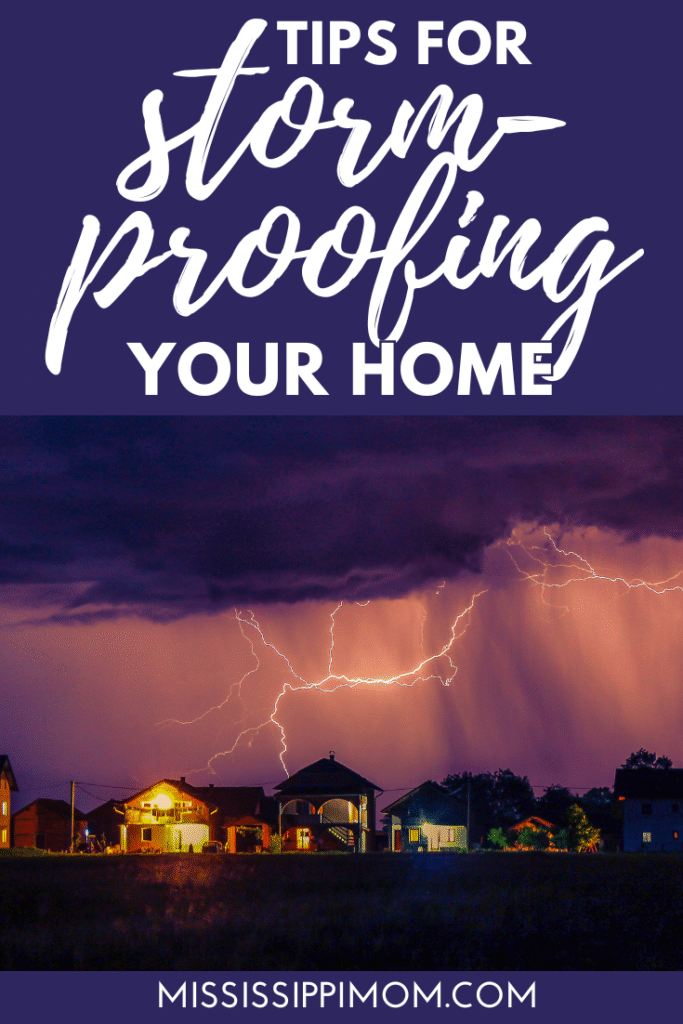This post may contain affiliate links to products or services mentioned, and we may receive an affiliate commission for any purchases made by you on the affiliate website using such links.
It’s hurricane season, and we live just close enough to the Gulf Coast to get concerned when the tropics get active. After all, while the world watched New Orleans in the aftermath of Hurricane Katrina, the “landmass” I live in was without power and water for months in some places, including the area where we live. (And, no, we will NEVER forget being called a “landmass.”) So, when the weather gets dangerous, how do we prepare our homes? From keeping interior features well-maintained to ensuring water doesn’t come inside, here are some helpful suggestions for storm-proofing your home.
Take Care of the Home’s Exterior
The elements can hit hard and fast, and your protection and safety are only as good as the exterior of your home. Lightning, the drumming of hard rain, and raging winds can be devastating and dangerous. Keeping the inside of your home dry all begins with your roof, and roofing companies like Legacy Roofing can help you have peace of mind about the state of your roof before the storm strikes.
Have Interior Systems Checked
Like the outside of the home, there are internal features that need to be checked and maintained. The outside might be able to withstand an impact, but it can shake interior systems. One of the most critical is, of course, the electrical system. Electricity during an emergency can be a huge advantage and a lifeline. Surge protection devices can take a hit from lightning, so be sure to have them in place to protect your electronics. Also, if you are able, consider adding a generator to your home. Ours came in handy after a tornado, as well as after an ice storm.
Home Peace of Mind with an Emergency Plan
I am not a planner. That’s why I married an engineer. He likes to have plan a, b, c, and so on. Even if you have prepared your home for bad weather, you need to prepare your family. Here are a few ways to do that.
- Ensure everyone knows what to do during an emergency. When tornado sirens go off, my kids know to have their shoes on and head to the hallway.
- Designate a safe room in the house that can offer protection from a severe storm. In our home, our downstairs hallway is the safest spot. Your home’s might be an interior bathroom or a basement.
- Keep emergency supplies stocked, including first aid, food, water, and extra blankets. Water is probably the biggest issue for us because if our electricity is off, so is our water pump. In addition to buying water bottles or gallon jugs if we know bad weather is coming, we will fill containers from the sink before we lose power.
Ensure Water Can’t Come Inside
Water can cause enormous damage to your home, and there are many features of a home that work to ensure water is diverted away to minimize the impact it has. Taking care of these is critical. The roof, gutters, and drainage systems are perfect examples. Inspecting these every couple of months, especially before and after a storm, can help keep them working as efficiently as possible for water runoff.
Don’t Forget About Insurance
Insurance can provide huge peace of mind, especially after a storm or event beyond your control. Even with the best storm plans, there’s not much you can do if a big one hits, but insurance helps you get back on your feet as it can pay for repair work and even a new roof. Keep your policy paid up and check every now and then to be sure you understand the coverage your plan provides.
Disclosure: this is a collaborative post and may contain affiliate links.
